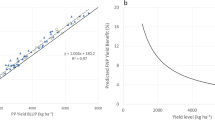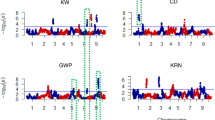Abstract
IT is well known among maize-growers that the number of rows of grain on an ear of maize varies from 8 to 24, or even more, according to the breed; also that in the same breed the number may vary within certain limits, e.g. 8, 10, or 12 in some breeds, 12, 14, 16, or 18 in others and 18, 20, 22, or 24 in yet others. In some breeds the range of variation is even greater than I have indicated, while in others it seems to be more closely limited. In some breeds an ear carrying more than 8 rows is considered untrue to type, but I am not aware that any South African grower has yet succeeded in fixing the number of rows in any breed to such a degree that no variation occurs in that respect.
This is a preview of subscription content, access via your institution
Access options
Subscribe to this journal
Receive 51 print issues and online access
$199.00 per year
only $3.90 per issue
Buy this article
- Purchase on Springer Link
- Instant access to full article PDF
Prices may be subject to local taxes which are calculated during checkout
Similar content being viewed by others
Author information
Authors and Affiliations
Rights and permissions
About this article
Cite this article
BURTT-DAVY, J. Inheritance of Row-numbers in Maize Ears. Nature 86, 347–348 (1911). https://doi.org/10.1038/086347b0
Published:
Issue Date:
DOI: https://doi.org/10.1038/086347b0
Comments
By submitting a comment you agree to abide by our Terms and Community Guidelines. If you find something abusive or that does not comply with our terms or guidelines please flag it as inappropriate.



